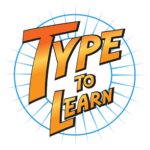The most important reason to provide a child with intentional typing lessons is to avoid bad typing habits. These habits come quickly and are hard to break. Type to Learn provides a variety of activities specifically designed to avoid adoption of these common bad habits.
Bad Habit #1: Bad Posture
Global studies have reported that 60% of children experience strain to their eyes, neck, shoulders, wrists, and back as a result of computer use (Hajic, 2008, para. 4). You have probably seen and experienced in your own life just how common it is for a person sitting at a computer to hunch over the keyboard. Maintaining proper ergonomics when typing is something that can significantly improve a child’s health and safety when spending large amounts of time at a computer.
Type to Learn directly addresses the importance of posture in every lesson by starting with visual and verbal directions to teach and remind the student of how to sit and interact with the keyboard safely. We also encourage teachers to require eye breaks every 5-10 minutes by asking the student to look away from the screen and focus on something across the room. This reminds them to rest their eyes regularly and prevent eye strain. For more information about ergonomic exercises, download our free infographic, 7 Ergonomic Exercises Students Should do While Typing.
Bad Habit #2: Looking at the Keyboard
Staring at the keyboard while typing is one of the most common bad habits in children. If the student typing has to search for keys to the point that they can no longer look at the screen, this indicates a lack of familiarity and confidence with the keyboard, which results in compromised speed and accuracy. It also delays transmission of ideas from the mind to the document and can cause children to become frustrated and uninterested in writing.
Type to Learn addresses this directly in early lessons. Visual depictions of the keyboard encourages the student to look at the screen as they search for a key. As the program progresses, repetitive activities teach a child the position of a key and instills muscle memory so that visually searching for the key is no longer necessary.
Bad Habit #3: Compensating for Irregular Keys
The home row letters and basic alphabet can come pretty quickly and naturally, but even students who are well familiarized with these can get caught up on things like capitalization, symbols, and numbers. Truly comprehensive keyboarding skills should include all letters, numbers, symbols, and shortcuts. Having to stop and look at the keyboard in order to use shift or enter, to find number placement, or locate a symbol decreases typing speed in addition to delaying thought processing.
Type to Learn provides specialized activities to directly address non-alphabetical and lesser used keys. This includes numbers, punctuation, and using shift to access capital letters and symbols. The repetition of these activities instill these abilities into a student long term.
Bad Habit #4: Prioritizing Speed Over Accuracy
If a student tries to type faster than they are able, accuracy will plummet. This forces them to return and remedy errors, which negates the speed they were trying to achieve in the first place. This habit is a result of not learning the keyboard in the right order and at the right pace. Developing exceptional keyboarding skills is something that requires time, precision, and order. After this foundation is solid, speed will come naturally while maintaining accuracy.
Type to Learn starts every lesson with a review of the home row keys, and the keys that the student has learned up to that point. This encourages the student to remember what they have learned and integrate it into the new information in the upcoming lesson. Specific activities are provided to encourage the student to slow down and learn exactly the path their fingers must take to hit a certain key. These activities have a metronome to encourage a steady cadence in typing so a student does not type faster than they can remain accurate.
Bad Habit #5: Lack of Right Hand-Left Hand Coordination
Choppy or delayed typing can be indicative of a lack of coordination between the hands. It can also be seen in hitting the keys too hard, or not hard enough. This lack of coordination stunts both speed and accuracy, and is a result of rushed or unorganized introduction to the keyboard.
Type to Learn has specific activities designed to foster coordination between the hands and fingers while typing. These activities ask students to type words that require just the right or just the left hand as quickly and accurately as possible. Other activities are specifically designed to teach frequent letter combinations or words such as “th,” “at,” and “me.” As muscle memory develops for these common combinations, processing time drops significantly and coordination between the two hands increases. This results in greater speed, accuracy, and fluency.
Because typing is such an important skill in our digital world, it is vitally important that it is taught correctly. Instilling proper habits early on will empower a student as they move through their schooling and career. Type to Learn provides a fun, research-based, interactive learning environment for your students to develop these skills.
Hajic, M. (2008). Kids & computers – children at risk for RSIs. Retrieved on May 20, 2016, from, http://www.bellaonline.com/articles/art50174.asp.





